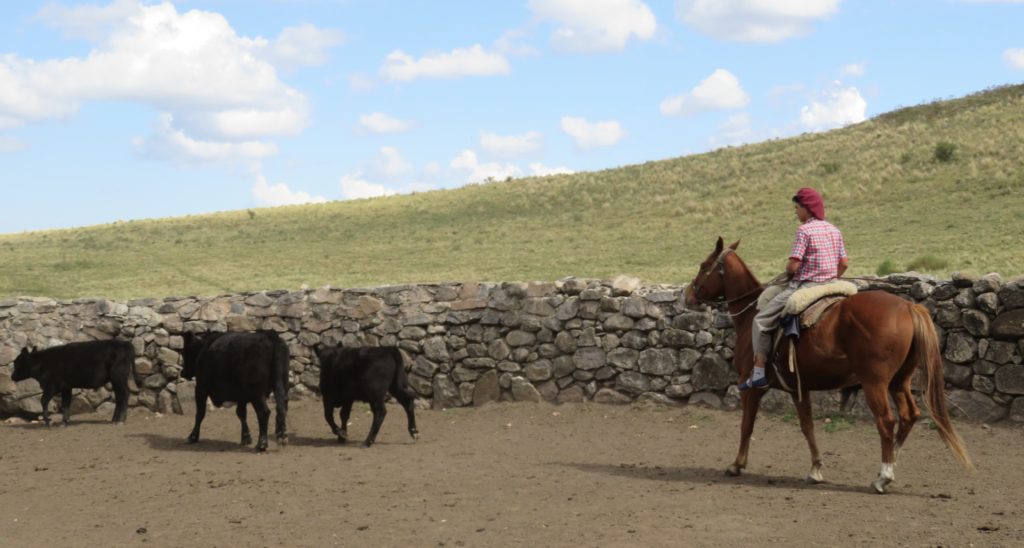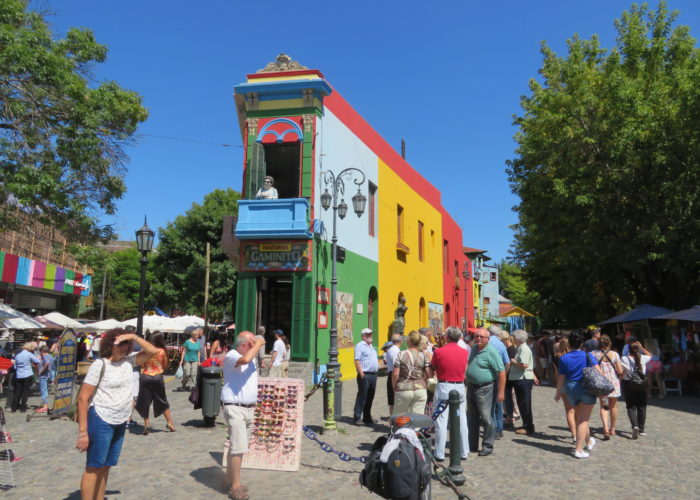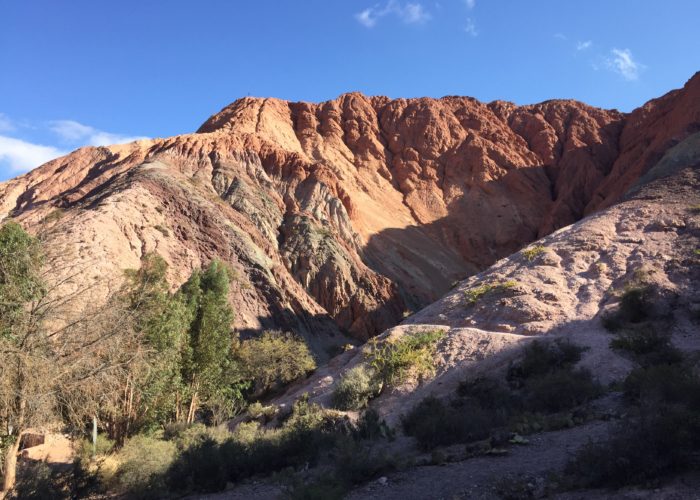Argentina is vast from the high Andean peaks in the North and the border with Chile through to the ranch country on the rich pampas soils through to the dramatic landscapes and ice fields of Patagonia. In Buenos Aires, Argentina has one of the most sophisticated cities in the world, though many of Argentina’s other principal cities of Córdoba, Mendoza, Salta etc. are also sophisticated modern cities. Over the years, the Argentinian economy has been miss-managed and from being one of the wealthiest countries in the world in the early 1900s, Argentina has fallen well behind Europe and the emerging economies of Asia. Nevertheless there is a pride and sophistication all over Argentina, which if you can insulate yourself from the many economic crises makes Argentina potentially a very pleasant place to live.
Buenos Aires is where most visitors will enter Argentina, and with its sophisticated museums, restaurants, markets and music has enough to keep a visitor occupied for a long period. The make up of Porteños as citizens of Buenos Aires are called is an interesting hybrid of the different European cultures that migrated to Argentina, with the underlying Spanish community, a large influx of poorer Southern Italians together with intellectuals from France and entrepreneurs from England, wanting to make money from the rapidly expanding agricultural lands that surround the city. Further south in Patagonia there are distinct communities from the Basque region in Spain, with their distinctive berets, which have become part of the gaucho attire, together with many Scots who came via the Falkland Islands to run many of the Patagonian sheep ranches and also a distinctive Welsh community near Puerto Madryn who retain their Welsh language and also speak Spanish with a distinctive Welsh accent.
The Argentinian dance, the tango, is a distinctive part of the country’s culture, and with its dramatic and passionate moves should be on every visitor’s list of things to do. The tango is also widely performed in the streets, and on Sunday’s in the San Telmo district of Buenos Aires whole squares are taken over by tango events, where all generations participate. Argentina’s other big passion is football, none more so when the Boca Juniors play River Plate. The distinctive light blue and white stripes of the national football team shirt are worn all over the country, ofter with number 10 with either Messi or Maradona on the back .
Destinations

- Buenos Aires
- Puerto Madryn
- Camarones
- El Calefate
- El Chalten
- Ushuaia
- Bariloche
- Mendoza
- Cordoba
- Rio Ceballos
- Tucaman
- Salta
- Buenos Aires

Argentina’s capital city Buenos Aires, a genuine world-class city that compares with many of the big cities in the world, dominates the whole country and practically every visit to Argentina will involve spending some time in Buenos Aires.
Buenos Aires has a character that reflects its birth from multiple settlers from most major European countries, and in its heyday in the early 20th Century it was one of the wealthiest cities in the world. Its principal streets are wide boulevards that reflect the influence of Paris at the time, while much of its population growth at the time came from a large influx of migrants from Southern Italy, together with the finance and capital from Britain, who in particular built the railways and developed much of Argentina’s agriculture in the hinterland surrounding Buenos Aires.
While Buenos Aires does not have the beautiful geographic back drop of Rio de Janeiro’s harbour or the mountains like Santiago de Chile, its top sights are every bit as impressive and reflect its cultural background. Our top five sights are:
- San Telmo District and the street Tango on Sunday’s where the whole community, young and old join in Argentina’s national dance.
- La Boca and La Bombonera complete with it’s brightly coloured buildings and the nostalgic old football ground complete with the passionate fans of Boca Juniors.
- Recoleta Cemetery, which must be some of the most expensive real estate in the country, as the massive graves and mausoleums compete with each other as to who can show off the most ostentatious wealth. Also housed here is the shrine to Evita, who in many ways seen as the Madeline figure of Argentina.
- The Colon Theatre and the many bookshops including the magnificent El Arteno Splendid housed in an old theatre. Argentina is one of the worlds largest publishers of books and these nicely show off the country’s great artistic and literary heritage.
- The bars, restaurants and café culture of the Palermo district
2. Puerto Madryn

Puerto Madryn is one of the most unusual towns in the whole of South America where there is one of the largest Welsh communities outside Wales. The local population even speak Spanish with a distinctive Welsh accent. The Welsh settlers escaped from cultural and religious persecution they experienced in Britain in the mid 1800 and after a difficult start have built a robust Welsh community in Patagonia. The tea houses in Trelew are a surreal experience where you can have afternoon cakes and tea just like in Wales and the wider British Isles.
Nearby Puerto Madryn is the Valdez peninsular, which is a UNESCO World Heritage Site where there are numerous marine mammals both on the shore and the sea off the coast. If you are luck you can see the whales breeding and also orcas beaching on the shore to pick off the young sea lions and the mammals. The land is very dry, but also has an abundance of birds and mammals including armadillos and guanacos.
3. Camarones

Further down the coastline is the small town of Camarones, which is famous for its large breeding colony of Magellanic penguins. Offshore are pods of marine mammals after some easy pickings of young penguins. The main colony is well organised with raised wooden walkways that visitors use to get close to the penguins without overly disturbing the birds.
4. El Calafate

Further south in Patagonia is the resort town of El Calfate, which is a pleasant base for exploring the surrounding Parque Nacional Los Glaciares complete with spectacular mountains and glaciers. The Perito Moreno Glacier is world famous and stands at over 100 metres tall and some 5 kms wide as it flows into Lago Argentino. The glacier is continually moving and the rupturing of the ice into the lake come with huge explosions. Not only is the scale of the glacier immense, the colours and variety of blues are stunningly beautiful.
5. El Chalten

At the top end of Parque Nacional Los Glaciares is the small resort town of El Chalten that makes a good base to trek in the surrounding mountains. Mount Fitzroy, named after the captain of Darwin’s ship the Beagle is a particularly beautiful mountain with its crags, glaciers and corrie lake. In the autumn season when we visited the vegetation was all turning into its autumn colours with lots of reds, oranges and yellows to add to the spectacular panoramas.
6. Ushuaia & Tierra del Fuego

Tierra del Fuego at the foot of South America is often called the end of the world and still feels a bit like it, being very isolated and experiencing huge winds and a barren landscape. Many of the famous explorers went to Tierra del Fuego and navigated either the Beagle Channel or the Magellan Strait to cross form the Atlantic to the Pacific Oceans and avoiding the extremely dangerous Southern Ocean.
The landscape has a natural beauty and the light reflecting off both the snow capped mountains and the waters makes for a dramatic site. The human history in addition to the explorers also reflects both the harshness of the environment and its remoteness. Ushuaia is the natural base for hopping off to the Antarctic, but also has a darker history of its own, particularly the old penal colony with its harsh conditions.
7. Patagonia

Patagonia is vast, it takes the best part of a week to travel from Ushuaia up to the Lake District or Buenos Aires. Argentinian Patagonia has very little rain and is almost desert like in climate. The ranches for sheep and other livestock can be the size of a small country like Belgium. Patagonia also has a large stock of wildlife, including many guanacos and rheas that are able to navigate the fences keeping in the livestock. Driving along the Ruta 40, the highway hugs the edge of the Andes mountains, which make a dramatic backdrop to the vast open expanses of plains to the East.
About half way up Patagonia is the Cueva de las Manos Pintadas, an ancient set of cave paintings dating back to 1100 BC, set in the rock face on a large glacial valley. The large valleys contain a number of dry salt flats that because they are so remote are rarely visited. The night skies are also spectacular with the stars being crisply defined as there is no light pollution.
8. Bariloche

The Argentinian Lake District has a number of pictures perfect glacial lakes set in amongst a number of extinct volcanoes and alpine forests. The resort town of San Carlos de Bariloche is a good base to explore the surrounding lakes and mountains. Bariloche has the feel of an Alpine resort, albeit one with a typical English style church. There are many descendants from Germany and the beer is accordingly very good.
9. Mendoza

Mendoza nestled in the shadow of Aconcagua, at 6,962 metres, the tallest mountain outside the Himalayas, is a plant low rise city right in the heart of Argentina’s wine trade. There are multiple vineyards all around the city and it is well worth taking a tour of the many bodegas and sampling their produce. Malbec has become the definitive Argentinian grape, though modern viticulture is now branching out into more complex blends often with the Cabernet Sauvignon grape that create some very sophisticated wines. The whites largely consist of chardonnay grape which create variety through the soils and climate.
Mendoza also has a large student population and with it a microbrewery culture to complement the many fine wines. The city itself has suffered from a number of large earthquakes including the big one in 1861 which destroyed most of the original colonial buildings. While the architecture lacks the character of the old colonial buildings, the city is laid to in a grid radiating from the central Plaza Independencia, with four similar sized squares arranged at each corner of a larger square.
10. Cordoba

Cordoba, Argentina’s second city is an unexpected surprise, with a large student population and a number of fine religious buildings built by the Jesuits. The city also supports the many estancias and cattle farms in the surrounding countryside, and the quality of the meat in the central market is particularly good.
The area around Plaza San Martin and the surrounding streets by the principal university buildings is full of lively bars and restaurants.
11. Rio Ceballos

One of the bucket list of things to do in Argentina is to have the gaucho experience in an estancia. There are a number of estancias in the Cordoba area and we chose the Anglo Argentinian Estancia Potreros for a short stay. At the estancia there is an opportunity for extensive horse riding with the gauchos and guides that work on the ranch in the rolling countryside. There is also the possibility of trying out a bit of polo.
The estancia is a working farm and guests are able to observe the working aspects of the estancia where they breed some of the finest Aberdeen Angus cattle. The food at the estancia is largely locally sourced and the meats on the barbecue are some of the finest you can have.
12. Tucamán

Further north is the town of Tucamán, which is where Argentina declared its independence from Spain in 1861. Tucamán today is a working Argentinian town sitting in a region that produces large quantities of citrus fruits. It is also famous for being the centre of Argentinian rugby. Tucamán is quite laid back and does not receive many foreign tourists which makes it a pleasant town to wind down and experience a genuine Argentinian experience.
13. Salta

Salta is one of Argentina’s most attractive colonial cities with some beautiful architecture around the Plaza 9 Julio, including the Cabilido and the Catedral. To the west of the city is the Cerro San Bernardo which can be reached by cable car and offers some great views of the city. Also with a list is the Iglesia San Francisco which in common with other San Franciscan churches in South America has extensive treasures.
To the north of Plaza 9 Julio are many bars and restaurants including a number of peñas clubs which have live folk music.
There are a number of great trips that can be taken from Salta including the journey up the Toro River Valley, which the Train to the Clouds follows. The La Polvorilla Viaduct is an interesting meccano structure in some beautiful countryside. Further up the valley are some open mountain views and also one of the largest salt flats outside of Bolivia.
The small town of Pumamarca further north is a major tourist site, which attracts visitors to see the Cerro del os Siete Colores which is a mountain that has seven distinct bands of rock each in different colours.
Blogs
- http://highburynomad.com/buenos-aires-theatres/
- http://highburynomad.com/buenos-aires-la-boca-colour-and-football-tradition/
- http://highburynomad.com/buenos-aires-tango/
- http://highburynomad.com/buenos-aires-final-thoughts/
- http://highburynomad.com/puerto-madryn-wales-in-argentina/
- http://highburynomad.com/camarones-and-rn3-western-patagonia/
- http://highburynomad.com/el-calafate-perito-moreno-glacier/
- http://highburynomad.com/tierra-del-fuego-the-end-of-the-world/
- http://highburynomad.com/in-patagonia/
- http://highburynomad.com/el-chalten-changing-mountains/
- http://highburynomad.com/ruta-40-journey-back-north/
- http://highburynomad.com/san-carlos-de-bariloche-chocolate-and-lakes/
- http://highburynomad.com/mendoza-malbec-and-high-peaks/
- http://highburynomad.com/cordoba-jesuits/
- http://highburynomad.com/estancias-gauchos-and-horse-riding/
- http://highburynomad.com/san-miguel-de-tucuman-birthplace-of-argentina/
- http://highburynomad.com/salta-andes-meets-argentina/
Slideshow
Travel
Argentina has an efficient transport network, with modern multi lanes highways connection the principal cities. The intercity bus network connects all major cities with modern busses with large comfortable seats and host/hostess service between large bus terminals, which are similar to modern railway stations in Europe etc.
Many of the cities have a top up card system that covers busses, urban trains etc. that are also useable across multiple cities including Buenos Aires and many other cities.
Roads in Patagonia and more remote areas are less developed, though the amount of traffic is not great. Some roads in the mountain areas can be unpaved, but as rule travel anywhere in Argentina is relatively comfortable.
Some of the distances can be huge and in particular in parts of Patagonia you can travel for whole days without coming across any major settlements. Air travel is probably a sensible option if time is short.
For our journey around Patagonia we chose dragoman.com Patagonia and Beyond ZSB journey from Buenos Aires to Santiago. Overland companies like Dragoman have the advantage of flexibility that not only can take you to many inaccessible National Parks by public transport, but also have the advantage of being able to stop at view points on the way which intercity busses will simply pass through.
Costs
Costs in Argentina are heavily influenced by the exchange rates and resultant impact on local inflation rates, so can be quite expensive. With what seems a series of continual financial crisis, the Argentinian banking systems and currency markets can take a while to navigate effectively.
While drawing money out of ATMs at Argentinian banks is relatively easy and efficient, You are often charged a very high rate of charges for the privilege, often at rates greater than 10% which is very high even by South American standards. In addition there are relatively low amounts of cash you can withdraw at any one time, often with a limit of below USD 100 or equivalent. In the towns there are also many cambio bureaus that will exchange USD at more competitive rates. These operate on the grey market so are perfectly legal, but you will need to be careful when using these.
Using credit cards will also incur fees and sometimes different prices, but when considering what form of payment method to use, you need to factor in the additional fees and charges incurred in obtaining cash, which for hotels etc. often makes it more economic to use cards.
The cost of food for foreigners who have access to USD and currency can be quite cheap, beef for example is often a lot cheaper that chicken and all other meats.
Accommodation
Places we Stayed
- Buenos Aires: Mine Hotel Boutique
- Buenos Aires: Hotel Mundial
- Pichi Mahuida: Camping
- Puerto Madryn: Aca-complejo Touristico Camping Site
- Camarones: Camping Municipal, Camarones
- Jaramillo: Camping
- El Calafate: Hostel del Glaciar Libertador
- Tierra Del Fuego: Camping
- Ushuaia: Hostel del Glaciar Libertador
- Laguna Azul: Camping
- El Chalten: Hostel Pioneros del Valle
- Cueva de las Manos: Camping
- Tecka: Camping
- Bariloche: Hostal Los Troncos
- Mendoza: Air BnB
- Cordoba: Windsor Hotel And Tower
- Rio Ceballos: Estancia Los Potreros
- Tucuman: Swiss Hotel Metropol
- Salta: Air BnB








































